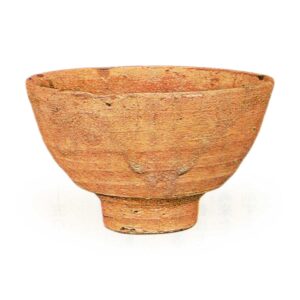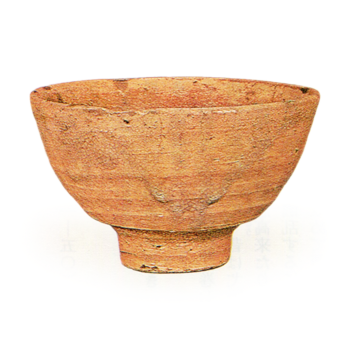
Among Korean well tea bowls, the famous hand well is called “Oido”. The name is probably due to its large size. In “Meimono Meiri Honsho,” it is written, “Oido is called Meimono Te, only because it is a large piece, and it is said to be well made in various ways among the pieces. The Meimono Teido has been the king of tea bowls since ancient times, and is said to have been made about six or seven hundred years ago. It has all the conditions for appreciation, including the prospective chasuri, chadamuri, inner and outer mouth potter’s wheels, body potter’s wheel, kairagi, the joints of the takaidai bamboo and the scenery inside the takaidai. The clay is white like rice field clay, and the glaze is a shiny loquat color with a little reddish-yellow tint. The glaze is flat from the outer surface from the mouth to the waist through the body, and therefore the glaze is also flat, but from the waist to the lower plateau, the glaze is interestingly rough, forming what is called a kairagi. The glaze from the waist to the upper part of the vessel has a faint white blotch, similar to an “toki kohiki” glaze, while many of the kairagi areas have a very pale, whitish, asagi-hue color. The characteristic feature of famous hand-wares is that the glaze covers the entire base and the clay is not visible, and the clay that is visible on the existing pieces is due to the fact that the glaze has naturally peeled off over a long period of time. The shape of the potter’s wheel is neat and graceful, and the wheel is well-polished, and the bamboo joints on the top are tasteful. The Oido owned by the Lord of Sendai, described in “Kokin Meibutsu Ruju”, later passed through the Akahoshi family and entered the Murayama family in Osaka in 1916, and the Oido named “Shiro” owned by Soji Yamagami was later presented to Hideyoshi Toyotomi and was displayed as one of the Taikoh’s tools at the Kitano Grand Tea Ceremony in 1587. It was used in the tea ceremony held at Kitano Shrine in the winter of 1878, and passed down to Kimura Gonemon of Osaka. The following are the most famous Oido teabowls still in existence. Kizaemon, Kaga, Tsutsuizutsu, Sogyo, Yuraku, Asano, O, Sakamoto, Hosokawa, Echigo, Matsunaga, Sakabe, Fukushima, Mino, Kanechiin, Rosho, Ki, Hori, Rikka, Ryukouin, Kuju, Honami, Okorai, etc. Taisho Meikikan”, “Chado Meimono Kou”, “Koryo Chawan to Seto no Chajiri”)


